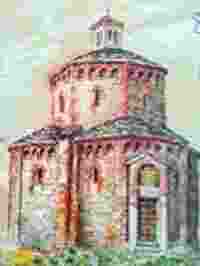Carmelite

The rule that the Patriarch Albert of Jerusalem gave to a group of Latin hermits gathered on Mount Caramel in the early century. XIII says, "The hermit brothers remain in their separate cells, day and night meditating on the Law of the Lord and watching in prayer.
Join Us
Therese Carmelite
"Meditate day and night, the law of the Lord" is therefore the classic formula by which the monastic tradition resumed command that even the Apostle Paul gave Christians to "pray without ceasing". The biblical precept of "unceasing prayer" has characterized the whole Church from its very beginning, and it is precisely this need that was born from the monastic experience.
It then descends Carmelite experience that, in view of monasticism, is always presented as "original and paradigmatic."
If Christians are expected to make the commitment that "all life is a continual prayer, obedience in every circumstance to the will of God, listening to the Word. The Monks instead being asked to make "prayer becomes life. Seeks the "quiet" interior (hesychia) and outer (desert), they would have achieved the ideal of a prayer that can embrace all the moments of life, day and night.
These were the goals of the early centuries: "To make life a prayer" and "make prayer life.
The monks, now become with time Cenobites, you assume the responsibility to ensure that all life, to become constant listening and fulfillment of the Law of God, "This hermitage is ideal as a thorn in the side, to lay people and monks, ever ready to rise in every period of Church history, as impetus for a "prayer totalizing."
The Carmelitanesimo at the start of sec. XIII, represents one of these revivals "hermits", that are developed according to traditional criteria of the ancient "Hesychasm" Patristic.
The very first "formula of life" that Albert, Patriarch of Jerusalem, wrote for hermits who had gathered spontaneously on the holy mountain of Caramel, was a slight correction in the sense of the ancient hermitage cenobitic.
The cenobitism, established for centuries, had understood early on that the hermitage is pure Christian dangerous because it threatens to steal the disciple of Christ to embrace community and ecclesial need to live in a concrete way the Incarnation of the Son of God L 'hermit radical, trying relentless ascent towards God, he might forget the need of the embrace of the Church of the brothers in faith.
For the first Carmelites' way of life "represents the balance as a result of the encounter between a fervent and spontaneous rebirth of vocation as a hermit and the wisdom of the century-old church that offers small and appropriate remedial community. But the project remains substantially intact hermitage and directions of the rules are basically those developed in the ancient Hesychasm.
Experience Carmelite adds something specific, however: those first hermits internalize a deep sense of responsibility, and the fact that they had gathered on the sacred mountain of Caramel, have felt the direct heirs of the great prophet Elijah, universally recognized as the founder of the whole monasticism.
Over time, this certainty, which traced the Carmelites even pre-Christian period, and connect with the birth of the Christ, in particular with the Blessed Virgin, meant that they felt with particular force and ecclesial responsibility the problem of fidelity to their origins hermit.
Experience hermits on Caramel could only last a few decades and ended with the fall of the Latin Kingdom (1261), with a forced migration of all the hermits in the West, where, however, had begun to move since 1235.
In the West the Carmelites first tried to persevere in the form of hermits, but were soon forced to assimilate to the forms of religious life flourished and then become similar to 'fraternity beggars. "To this end, the original "formula of life" was appropriately mitigated and approved as Rule by Innocent IV in 1247.
The history of the Order in the West is developing its first in a climate of responsibility toward the ancient primal identity and then to several attempts at reform.
The lifestyle became more cenobitic Carmelite convents and foundations in cities reduced their solitude as a hermit in an ideal state with an increasingly active participation in the "cure of souls" in the manner of other orders.
This step for the Carmelites was accompanied by strong doubts: they felt even more so the "problem" of those ancient noble connecting them to the prophet Elijah and the Holy Fathers of the Old and New Testament, and this made it more traumatic for them slippage towards form cenobitic, mendicant and apostolic way of life.
"We have left the world to better serve the Creator in the castle of Contemplation 'thus express the official documents again in 1287.
The hermitage is still its spiritual heritage of the Order, even though it was now understood primarily as a "hermitage of the heart," giving a privileged place in their lives to contemplation. Were regarded as the founder of the Order Elijah and Mary. In particular, the icon of the Annunciation to the Carmelites was the one that most expressed the sense and purpose of their vocation.
The Order was grassroots support through the dissemination of Marian devotion, especially through the devotion of the Scapular, simple method for the trust of the faithful to the Mother of Mercy, covering her children with her dress Saint.
 The rule that the Patriarch Albert of Jerusalem gave to a group of Latin hermits gathered on Mount Caramel in the early century. XIII says, "The hermit brothers remain in their separate cells, day and night meditating on the Law of the Lord and watching in prayer.
The rule that the Patriarch Albert of Jerusalem gave to a group of Latin hermits gathered on Mount Caramel in the early century. XIII says, "The hermit brothers remain in their separate cells, day and night meditating on the Law of the Lord and watching in prayer.